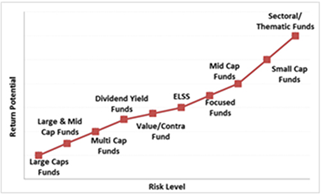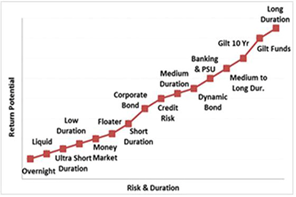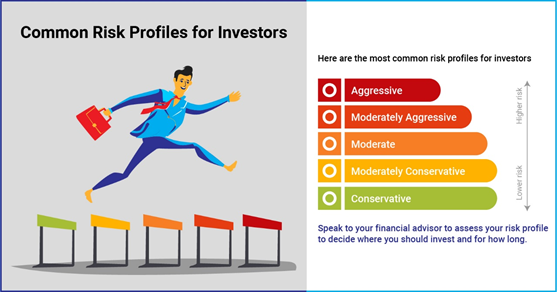When you invest your hard-earned money in mutual funds – a potent avenue for wealth creation – there are various types of risks involved: macroeconomic risk, inflation risk, interest rate risk, credit risk, liquidity risk, re-investment risk, and fund management risk among others. All these together are investment risks, which need to be carefully assessed by you, the investor.
| Type of Risk | Impact on the Mutual Fund |
|---|---|
| Macroeconomic Risk | Risk of a slowing economy leading to reduced demand, profit margins, earnings growth, etc., and eventually poor investment performance |
| Inflation Risk | The mutual fund returns will decline in value due to rising prices |
| Liquidity Risk | The mutual fund can’t liquidate its investments because there are no buyers |
| Reinvement Risk | The probability that an investor will have to reinvest money from an investment at a rate lower than its current rate. |
| Credit Risk | The probability of an investment loss resulting due to the borrower defaulting on debt obligations. |
| Fund Management Risk | Risks associated with managing an investment fund that could lead to an ineffective, destructive or underperforming management. |
| Market Risk | Unavoidable risks affect the entire market and so the value of the mutual fund’s investments have also declined as a result |
| Interest Rate Risk | The value of Fixed Income Securities declines when interest rates rises |
“Successful investing is about managing risk, not avoiding it,” said Benjamin Graham, the father of value investing, and the author of the famous book, The Intelligent Investor (published in 1949).
He further stated, “ The essence of investment management is the management of risks, not the management of returns. ”
Thus, when you are considering any mutual fund (or any other investment avenue for that matter), it is important to meaningfully compare risk and return, and not look at just the returns. Because, risk and returns, usually, go hand in hand. Only tracking the returns of a mutual fund scheme is not a thoughtful approach; it may be detrimental to your financial health and wealth creation journey.
Risk, as you may be aware, refers to the probability of an investment outcome differing from what you expected. It represents a possibility of losing some or all the principal amount you originally invested. So, the risk is nothing but a state of uncertainty, of more than one possible outcome – positive (good) or negative (bad). When negative outcomes outweigh the positives, the risk is high and vice versa.
You see, every investment you make carries a certain degree of risk. Even in the case of mutual funds – depending on the category (equity, debt, hybrid, solution-oriented, and others) and sub-categories therein, there is risk involved.
Graph 1A and 1B: Risk-Return Spectrum of Equity Mutual Funds and Debt Mutual Funds


The graphs above are indicative and for illustration purposes only
The graphs above are indicative and for illustration purposes only
Graph 1A depicts that in the equity funds category, the risk varies depending on the sub-category or the investment mandate of the scheme. For example, a large-cap fund is placed at the lower end of the risk-return spectrum as they invest in stocks of well-established companies, having reliable brand equity, customer loyalty, competitive advantage, large and deep moat, quality management, strong balance sheet, easy access to various resources, and sustainable business models). Whereas a sector or thematic fund is placed at the high end of the risk-return spectrum due to portfolio concentration risk and the fortune of the fund being closely linked with that of the sector or theme.
Similarly, this is the case with debt funds as depicted in Graph 1B. Overnight funds and liquid funds, since they invest in money market securities (viz. T-bills, Certificate of Deposits, Commercial Papers, repos, etc.) with shorter maturities, they are placed on the lower end of the risk-return spectrum. Whereas debt funds with longer maturities, due to credit risk, interest risk, and re-investment involved, are relatively riskier in the debt fund category.
When you approach mutual funds, choose the ones that are in congruence with your personal risk profile. The risk profile of every individual varies depending on his/her age, personal experiences, financial circumstances, the quantum of contingency reserve, knowledge about the financial products and markets, investment objectives, and investment horizon. Accordingly, this helps you determine the investment portfolio best suited to achieve your financial goals.

The table and illustration is for explanation purpose only.
Mutual funds are mandated to disclose risk-o-meter for every scheme. Depending on theirinvestment portfolio , a scheme may expose you to a certain degree of risk –– Low risk, Moderately low risk, Moderate risk, Moderately high, High, and Very High Risk. As per regulatory guidelines, fund houses are expected to evaluate the risk-o-meter on a monthly basis and disclose the reviewed risk-o-meter along with the portfolio disclosures for all their schemes on their respective website and the AMFI website (by the 10th of every month). Besides, they are mandated to disclose the number of times the risk level changed over the year. For you, the investor, it is vital to pay attention to this aspect to understand the risk traits of the scheme.
Further, there is a way to quantify the risk the mutual fund scheme exposes its investors to. In this regard, take a look at ratios such as the Sharpe Ratio (which measures the degree of risk – indicated by standard deviation – that a fund took to generate extra returns over risk-free instruments), the Sortino Ratio (which measures the fund’s ability to limit the downside risk), and the Treynor Ratio (measure the extra returns the fund manager has been able to generate over the risk-free rate for a given level of systemic risk, i.e. the beta) that shed light on the risk-adjusted returns of the scheme.
Read Related: Risk Measures in Mutual Fund
You should be mindful of schemes that expose you to extra-ordinarily high risk but don’t compensate enough on a risk-adjusted basis. In a rising market, most mutual funds may fare well, but the true test would be in assessing how they are able to limit the downside risk volatile and corrective phases of the market.
Thus, in the endeavour to counter inflation and fulfilling the envisioned financial goals, while generating good returns is important; the risk-adjusted returns cannot be ignored.
In this exercise, care needs to be taken to compare schemes within the same category and with comparable indices–––and not apples with oranges. For example, if you have invested in a Large Cap Fund, compare its performance with only other large-cap peers and not with any mid-cap biased scheme. Similarly, don’t compare the performance of debt funds with equity funds. Also, compare schemes on similar time frames. Keep in mind, that a prudent comparison of mutual funds would aid you in selecting the best mutual funds to accomplish your financial goals.
It is important for you to understand the different aspects of risk and how it applies to YOUR investment portfolio.
Set realistic risk-return expectations to build wealth with mutual funds.
Happy Investing!
Disclaimer: The views expressed here in this Article / Video are for general information and reading purpose only and do not constitute any guidelines and recommendations on any course of action to be followed by the reader. Quantum AMC / Quantum Mutual Fund is not guaranteeing / offering / communicating any indicative yield on investments made in the scheme(s). The views are not meant to serve as a professional guide / investment advice / intended to be an offer or solicitation for the purchase or sale of any financial product or instrument or mutual fund units for the reader. The Article / Video has been prepared on the basis of publicly available information, internally developed data and other sources believed to be reliable. Whilst no action has been solicited based upon the information provided herein, due care has been taken to ensure that the facts are accurate and views given are fair and reasonable as on date. Readers of the Article / Video should rely on information/data arising out of their own investigations and advised to seek independent professional advice and arrive at an informed decision before making any investments. None of the Quantum Advisors, Quantum AMC, Quantum Trustee or Quantum Mutual Fund, their Affiliates or Representative shall be liable for any direct, indirect, special, incidental, consequential, punitive or exemplary losses or damages including lost profits arising in any way on account of any action taken basis the data / information / views provided in the Article / video.
Mutual Fund investments are subject to market risks, read all scheme related documents carefully.